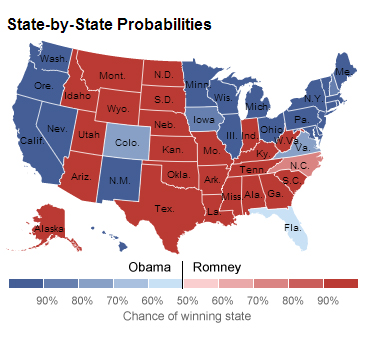The end has come. No, not the end of the Incan calendar, nor armageddon, just the end of the election. Evaluation and data has long been a campaigner’s tool. Focus groups are used to test speeches and arguments. Polls are conducted to track trends and predict outcomes. But one thing bothered me this year: instead of polls guiding discussion, they became the discussion. Pundits were arguing that the data was wrong. Well vindication came Election Day and it was led once again by Nate Silver.
How does he do it?
Silver does not have a political science degree, and never worked for a campaign or in politics so it is not intuition. Instead, Nate Silver is a statistician and relays on numbers, publicly available numbers. That is right, the
numbers that the campaigns say they never look at (that’s not quite the truth) or this year we heard were not accurate, Silver is able to use to predict the results nearly perfectly.
After compiling all the polling available, Silver has created an algorithm for merging polls together to make an even more accurate prediction. Why is it more accurate? By increasing the sample size, and removing some error created by polling firms having to predict voter turnout (they were slightly off) his model has less fluctuation. However the important reason he is able to accurately predict the results is he lets the data speak for its self and does not place political “filters” in front of it to use the numbers to support a specific desired result.
For anyone who thinks you won’t need to stay up late November 8, 2016 I have some bad news, Silver has suggested that he will be leaving the world of politics to start analyzing more macro subjects. However, his blog and algorithm will probably stay with the New York Times so hopefully they will continue his work.
What can we learn from Silver and this election?
Data that is collected in a sound way is extremely powerful. No one hires a pollster or evaluator to tell them what they want to hear. They are hired to produce accurate reports which will lead to good decisions or changes. Take time to consider what information you need to improve your organization and then determine the best way of collecting information. Once you have data, open yourself up to the results. They might not always be what you expected but do not just rule it off.
Analysts needs to let data speak for itself; try to control the impact of bias. This year, as I mentioned, the news was often filled with pundits attacking the polls. This election the impact of bias became all too clear on Fox News where Karl Rove who serves as a pundit went against a decision that the data team made. His bias was pointed out when Megyn Kelly asked him “is this just math that you do as a Republican to make yourself feel better or is this real?” Humans by nature are biased and if unchecked, bias will distort any information and conclusions drawn from evaluations. If you are conducting internal evaluations, discuss ways to reduce the impact of bias.
The Daily Show ran a great segment after the election where Jon Stuart points out these two take always in his satirical ways. The enbed was not working but you can watch it here: http://www.thedailyshow.com/watch/wed-november-7-2012/post-democalypse-2012—america-takes-a-shower—karl-rove-s-math

